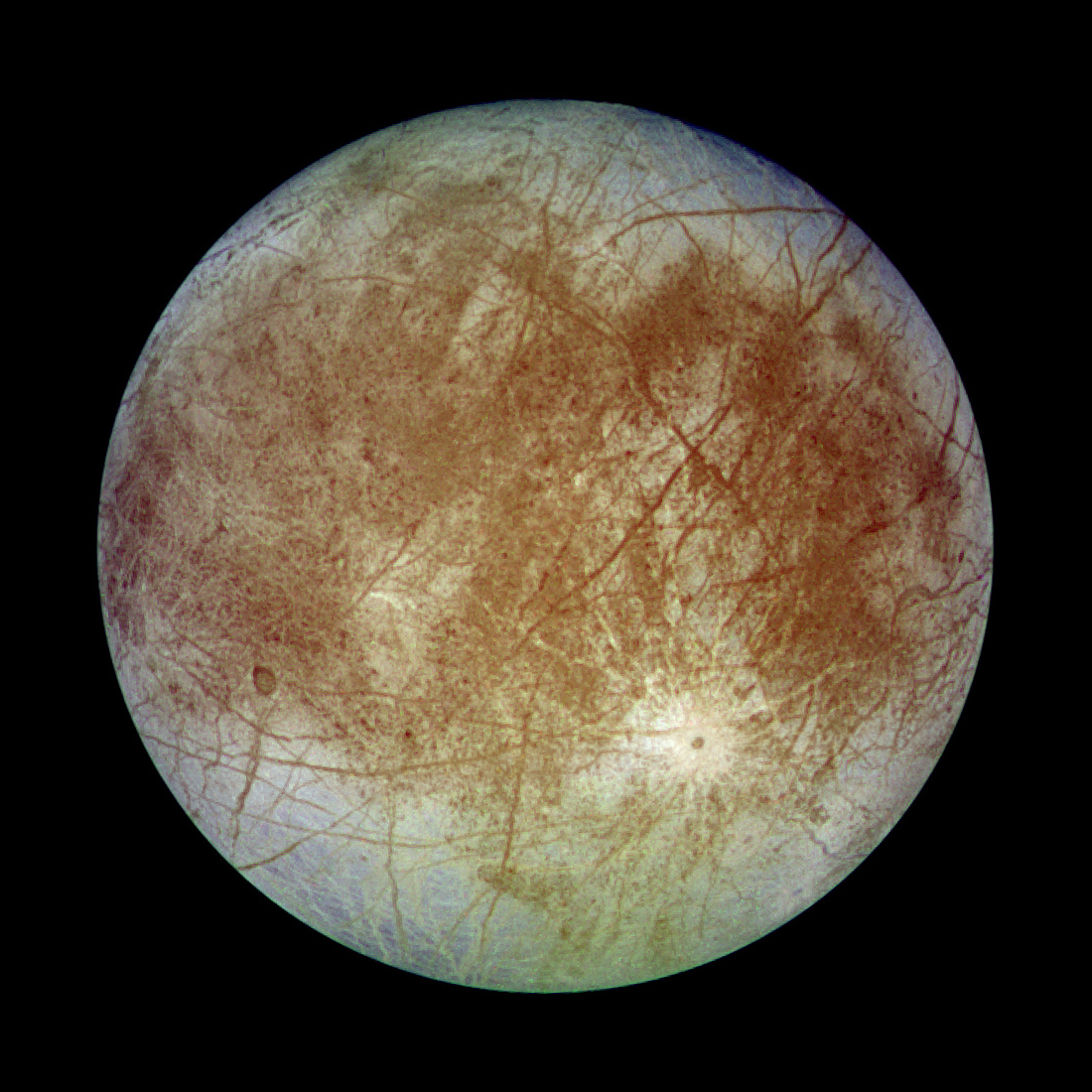
By Glenn A. Walsh
Reporting for SpaceWatchtower
While 2024 has been the targeted year for launch of Artemis and the return of astronauts to the Earth's Moon, NASA is also targeting a mission to another moon in 2024. The ice-covered moon of Jupiter, Europa, possibly with deep oceans, will be the first moon outside of the Earth-Moon system to receive a dedicated space probe.
This month, the main body of the space probe, known as the Europa Clipper, arrived at NASA's Jet Propulsion (JPL) in Pasadena, California. Now, JPL engineers and technicians will assemble the spacecraft and prepare it for launch.
The assembly will include installation of the nine science experiments on-board. Launch of the Europa Clipper is scheduled for October of 2024. The probe should arrive and enter an orbit of Jupiter in April of 2030.
“It’s an exciting time for the whole project team and a huge milestone,” said Jordan Evans, the mission’s project manager at JPL' as part of a NASA news release. “This delivery brings us one step closer to launch and the Europa Clipper science investigation.”
After entering orbit of Jupiter, Europa Clipper will conduct 44 fly-bys of Europa over a mission length expected to last 8 years.
Why not enter actual orbit of Europa, which is just a little smaller in size as the Earth’s Moon? Radiation emanating from the Jupiter magnetosphere at the orbit of Europa makes remaining this close to Jupiter dangerous for any spacecraft.
Europa's orbit lies completely within the harsh radiation fields of Jupiter. Even a hardened spacecraft, within such radiation fields, would last only a few months.
The problem is not the speed of scientific data accumulation. The scientific instruments can gather data pretty rapidly, so the limited life-span of the probe in Europa orbit would not have been a problem.
The problem comes when trying to communicate the data back to Earth. Because there are a limited number of receiving antennas on Earth, it takes longer to send the data back to NASA. Hence, the orbit of Europa will be elliptical, allowing the spacecraft to exist a fair amount of time beyond the radiation belts so it could survive for a longer period of time.
The Europa Clipper consists of an aluminum cylinder measuring 10 feet / 3 meters tall and 5 feet / 1.5 meters wide. This space probe will be launched a-top a SpaceX Falcon Heavy rocket.
Once the Europa Clipper gets to work in 2030, the probe will be looking to determine this moon's habitability. It will seek information on the atmosphere, surface, and interior of this small planetary body.
In particular, the probe will seek water plumes coming from fractures in the surface ice. It is estimated that water below the icy surface of Europa could exceed the amount of water in all of Earth's oceans, possibly by two times. Hence, scientists will be evaluating these water plumes to look for evidence of life in the ocean of Europa.
The Europa Clipper is named after 3-masted, ocean merchant vessels of the 19th century.
Europa was one of the first four non-Earth moons discovered, following the invention of the astronomical telescope. Famous Italian astronomer Galileo Galilei discovered Europa with his telescope on 1610 January 8. Europa was one of the four moons he found orbiting Jupiter that evening, including the natural satellites Io, Callisto, and Ganymede; these are known as the Galilean moons.
Europa is the smallest of the four Galilean satellites, and the 6th closest to Jupiter of the 80 known Jupiter moons. Europa is also the 6th largest moon in our Solar System.
The name Europa is taken from the name of the daughter of Tyre, a Phoenician noble-woman of Greek mythology; all four Galilean satellites are named after a lover of Zeus, the Greek counterpart of Jupiter
Internet links to additional information ---
NASA/ JPL News Release on Europa Clipper: Link >>> https://www.jpl.nasa.gov/news/nasas-europa-clipper-mission-completes-main-body-of-the-spacecraft
Europa Clipper -
Link 1 >>> https://www.nasa.gov/europa
Link 2 >>> https://en.wikipedia.org/wiki/Europa_Clipper
Europa >>> https://en.wikipedia.org/wiki/Europa_(moon)
Galilean Satellites: Link >>> https://en.wikipedia.org/wiki/Galilean_moons
Galileo Galilei: Link >>> https://en.wikipedia.org/wiki/Galileo_Galilei
Source: Glenn A. Walsh Reporting for SpaceWatchtower, a project of Friends of the Zeis
Monday, 2022 June 13.
Like This Post? Please
Share!
More
Astronomy & Science News - SpaceWatchtower Twitter
Feed:
Link >>> https://twitter.com/spacewatchtower
Astronomy & Science Links: Link >>>
http://buhlplanetarium.tripod.com/#sciencelinks
Want to receive SpaceWatchtower blog
posts in your in-box ?
Send request to < spacewatchtower@planetarium.cc
>.
gaw
Glenn A. Walsh, Informal Science Educator &
Communicator (For more than 50 years! - Since Monday Morning, 1972 June 12):
Link >>> http://buhlplanetarium2.tripod.com/weblog/spacewatchtower/gaw/
Electronic
Mail: < gawalsh@planetarium.cc >
Project
Director, Friends of the Zeiss: Link >>> http://buhlplanetarium.tripod.com/fotz/
SpaceWatchtower
Editor / Author: Link >>> http://spacewatchtower.blogspot.com/
Formerly
Astronomical Observatory Coordinator & Planetarium Lecturer,
original Buhl Planetarium & Institute of Popular Science (a.k.a.
Buhl Science Center), Pittsburgh's science & technology museum
from 1939 to 1991.
Formerly Trustee, Andrew Carnegie Free Library
and Music Hall, Pittsburgh suburb of Carnegie, Pennsylvania.
Author
of History Web Sites on the Internet --
* Buhl Planetarium,
Pittsburgh: Link >>> http://www.planetarium.cc Buhl Observatory: Link >>> http://spacewatchtower.blogspot.com/2016/11/75th-anniversary-americas-5th-public.html
*
Adler Planetarium, Chicago: Link >>> http://adlerplanetarium.tripod.com
*
Astronomer, Educator, Optician John A. Brashear: Link >>> http://johnbrashear.tripod.com
*
Andrew Carnegie & Carnegie Libraries: Link >>> http://www.andrewcarnegie.cc
No comments:
Post a Comment